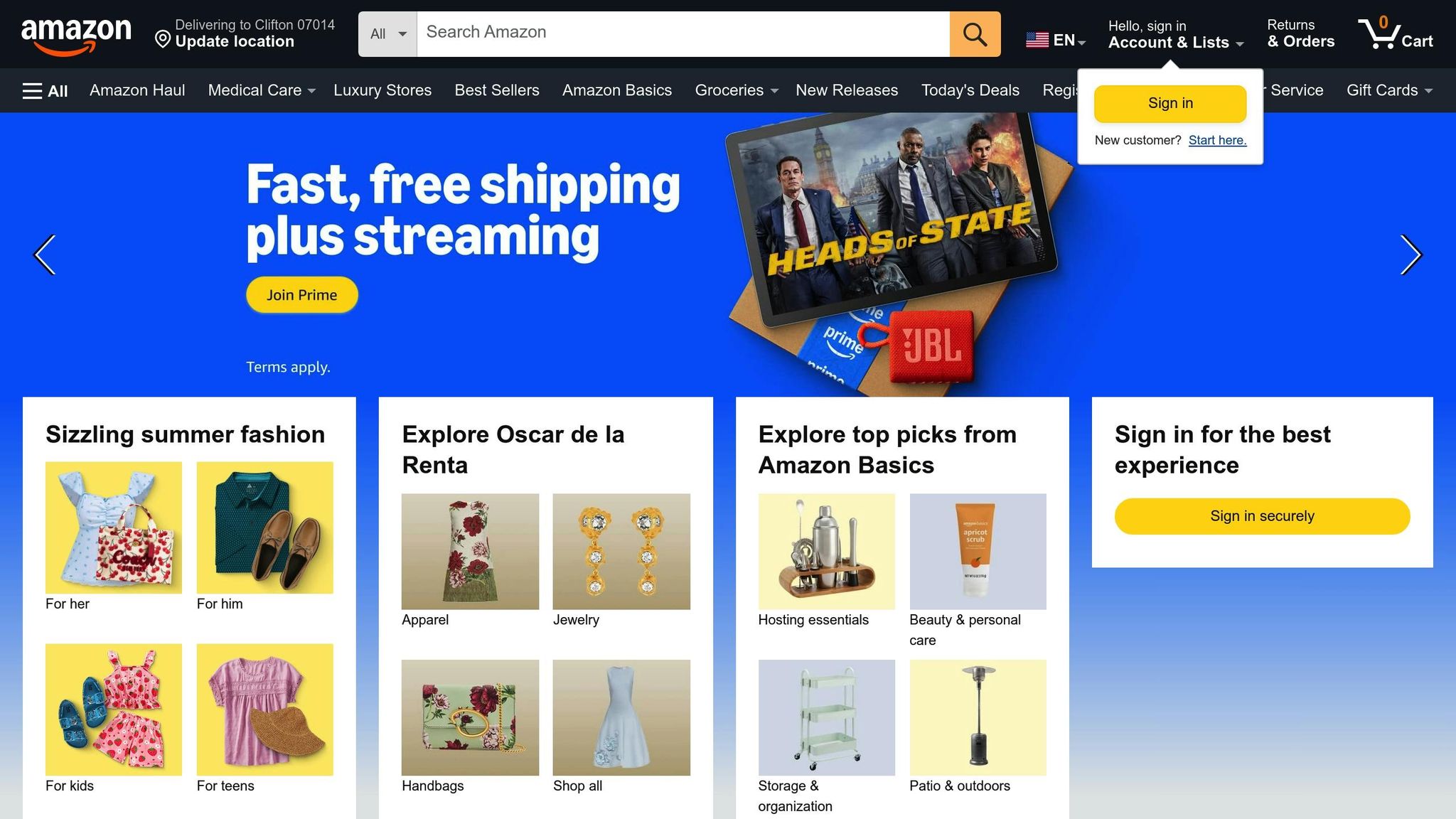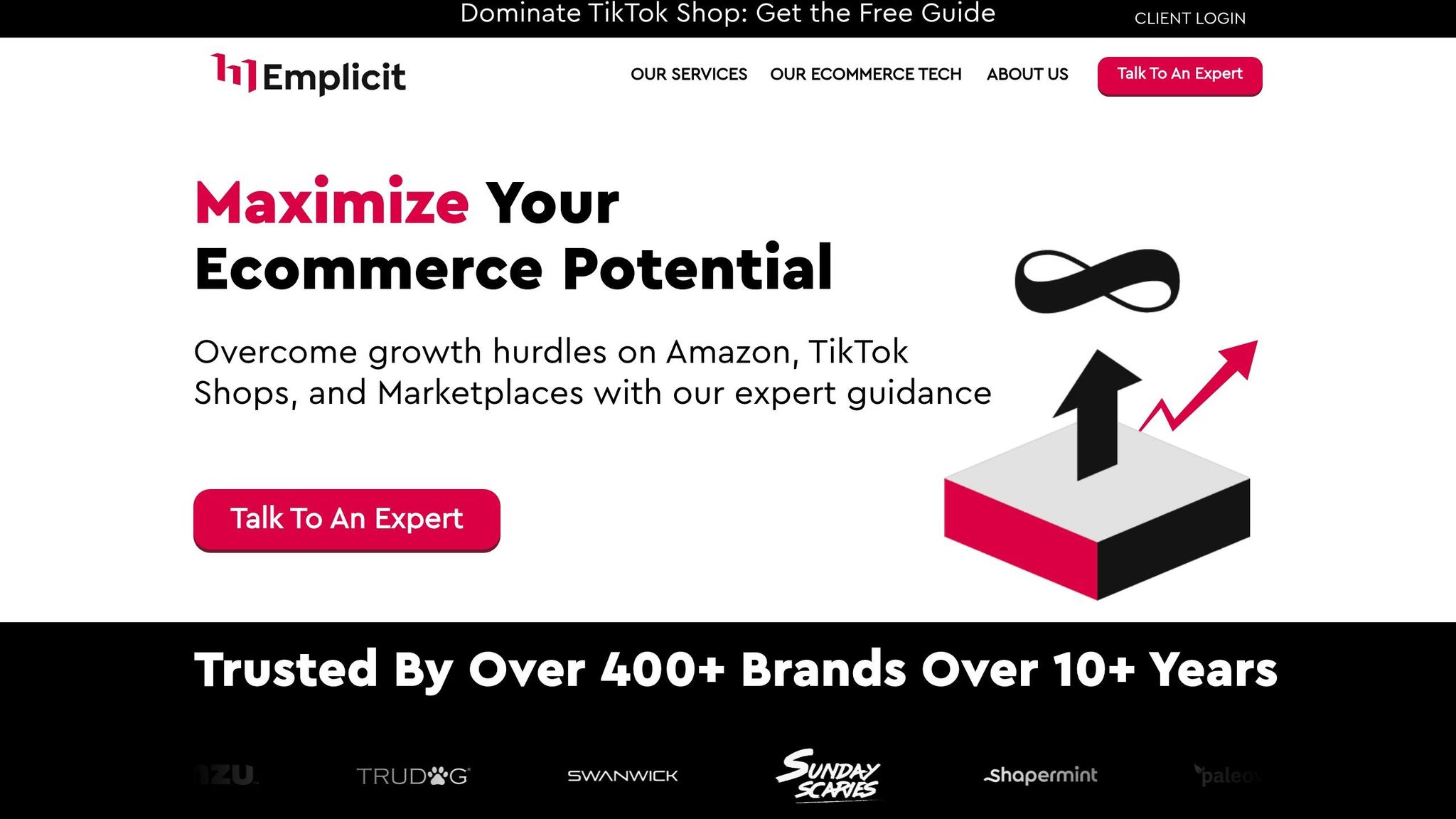
Amazon Sponsored Brands campaigns let you showcase your brand and products with ads that appear in prime positions on Amazon. Managing your ad budget effectively is key to avoiding wasted spend and maximizing returns. Amazon‘s budget rules help automate spending adjustments based on performance, schedules, or goals, ensuring your campaigns stay efficient. Here’s what you need to know:
- Daily Budgets: Best for ongoing campaigns, these adjust spending daily and can exceed the set limit during high-traffic days by up to 100%. Recommended starting point: $30 per day.
- Lifetime Budgets: Ideal for fixed-duration campaigns like seasonal promotions, where the total budget is allocated upfront. The campaign stops once the budget is spent.
Budget Rules:
- Schedule-Based Rules: Automatically increase budgets during key periods (e.g., holidays, Prime Day). These can be customized by date or tied to predefined events.
Best Practices:
- Allocate most of your budget to high-converting ad formats like Sponsored Products (e.g., 75% Sponsored Products, 20% Sponsored Brands, 5% Sponsored Display).
- Monitor performance metrics like ROAS and adjust budgets regularly to focus on what works.
For personalized support, companies like Emplicit specialize in managing Amazon ad budgets, offering tailored strategies and cross-platform expertise.
Key Takeaway: Use budget rules to automate spend adjustments, align with your goals, and improve campaign efficiency.
Set up your budgets for Amazon Ads

Daily vs Lifetime Budgets
When setting up your Amazon Sponsored Brands campaigns, you’ll need to decide between two key budget structures: daily budgets and lifetime budgets. Each serves different purposes depending on your advertising goals and campaign timeline.
How Daily Budgets Work
Daily budgets are designed for campaigns that run continuously. Amazon uses a flexible spending model, allowing your daily spend to exceed the set amount by up to 25% – or even 100% on high-traffic days. This flexibility ensures your ads can take full advantage of days when traffic and performance are higher. For example, if you set a daily budget of $30, your spending might spike during peak traffic periods and slow down on quieter days.
One big advantage of daily budgets is their adaptability. You can adjust them anytime, making them a great choice for campaigns focused on ongoing brand discovery or performance testing.
How Lifetime Budgets Work
Lifetime budgets operate differently. Instead of pacing spend daily, the total budget is allocated upfront and used over the campaign’s entire duration. This approach is ideal for campaigns with a fixed timeline, like seasonal promotions or limited-time offers. Once the total lifetime budget is spent, the campaign stops running, ensuring you stay within your set limits.
This type of budget works well for advertisers who want to control spending over a specific period without worrying about daily adjustments.
Budget Amount Recommendations
For US-based campaigns, it’s recommended to start with a daily budget of around $30. This amount typically provides enough data to optimize performance, while smaller budgets may delay exiting Amazon’s learning phase.
For lifetime budgets, match the total spend to your campaign’s goals and duration. In short, daily budgets are better for ongoing brand-building and experimentation, while lifetime budgets are more suited for time-sensitive promotions or campaigns with a clear end date.
Types of Budget Rules
Amazon provides automated budget rules that help streamline spending adjustments. One widely used option is the schedule-based rule, which relies on time-specific triggers to adjust your daily budget during important promotional periods. Let’s dive into how these rules can help optimize spending for key events.
Schedule-Based Budget Rules
Schedule-based rules are triggered by specific time periods, automatically increasing your campaign budgets by a set percentage during those times. They’re especially effective for seasonal promotions, holiday sales, and major events like Prime Day or Black Friday.
For example, if you sell Halloween costumes, Amazon might suggest setting up a budget rule for the weeks leading up to October 31st. These recommendations are often tailored to your product category, giving you a head start on planning.
You can apply multiple budget rules to a single campaign, and when their conditions overlap, the increases are applied cumulatively. So, if several rules are active simultaneously, your daily budget could receive a combined boost.
It’s worth noting that scheduling budget rules by specific hours of the day is currently available only in the US, Canada, UK, India, and Japan marketplaces.
Setting Up Budget Rules
Creating schedule-based budget rules in Amazon’s Campaign Manager is straightforward. Start by opening Campaign Manager and selecting the option to create a new schedule-based budget rule for your campaign.
When setting up the rule, choose "Schedule-based rules" as the type. You’ll then have the option to pick from predefined events – like major shopping holidays or back-to-school seasons – or set custom date ranges. For predefined events, Amazon provides suggestions based on your product category.
For custom scheduling, you can define the start and end dates, specify the percentage increase, and preview the adjusted budget to see how it impacts your campaign finances. These rules integrate seamlessly with Amazon’s automated systems, ensuring your spending stays aligned with your goals.
Once you’ve created a rule, you maintain full control. Budget rules can be edited, paused, or deleted at any time, giving you flexibility to adapt your strategy as needed.
sbb-itb-e2944f4
Budget Optimization Best Practices
Budget Allocation Across Ad Formats
How you allocate your advertising budget across different ad formats can significantly impact your results. Sponsored Products often take the lion’s share because they tend to generate higher click-through and conversion rates. Meanwhile, Sponsored Brands are great for increasing awareness, and Sponsored Display ads are an affordable way to retarget your audience.
For those just starting out, a common approach is to allocate about 75% to Sponsored Products, 20% to Sponsored Brands, and 5% to Sponsored Display. However, as your revenue grows, these percentages may shift. The table below outlines how budget allocations typically evolve based on revenue levels:
| Revenue Level | Sponsored Products | Sponsored Brands | Sponsored Display |
|---|---|---|---|
| Under $1M | 95% | 5% (Video only) | 0% |
| $1M – $5M | 85% | 14% (Video focus) | 1% (Retargeting/Category) |
| General Starting Point | 75% | 20% | 5% |
To get the best results, it’s essential to regularly track how each ad format is performing. By doing so, you can fine-tune your allocations over time to better align with your growth goals. Whether you’re focusing on conversions, brand awareness, or retargeting, revisiting and adjusting your budget can help keep your campaigns on track and performing efficiently.
How Emplicit Can Help with Budget Management

Managing budgets for Amazon Sponsored Brands ads can be tricky. Striking the right balance between spending and profitability often requires specialized knowledge and constant fine-tuning. That’s where Emplicit steps in to make a difference.
Expert Budget Strategy Support
Emplicit brings expertise in PPC campaign optimization and a solid grasp of Amazon’s advertising landscape. Their team works closely with brands to craft budget strategies that align with key performance indicators and seasonal shifts in demand.
But they don’t stop at just setting budgets. Emplicit actively monitors account health, inventory levels, and critical metrics like ACoS, ROAS, and conversion rates. By doing so, they ensure that budget decisions are always in sync with product availability and sales goals. This approach helps minimize wasted spending on campaigns for out-of-stock items or ads that aren’t delivering results.
With USA-based account managers, Emplicit offers hands-on, personalized support. They focus on making sure every advertising dollar is spent wisely, delivering better returns through strategic and attentive budget management.
Complete Ecommerce Services
Emplicit stands out by offering end-to-end ecommerce management. Budget management isn’t treated as an isolated task – it’s part of a larger strategy that includes listing optimization, inventory oversight, and expanding into new marketplaces.
Their expertise extends beyond Amazon. Emplicit also manages campaigns across platforms like TikTok Shops, Walmart, and Target, giving brands the ability to allocate budgets effectively across multiple channels. For businesses with their own ecommerce websites, they design integrated marketing strategies that aim to boost overall profitability.
Emplicit’s services are flexible, with options ranging from single-platform management to full-scale omnichannel strategies. This adaptability ensures they can meet the unique needs of different businesses.
What truly sets them apart is their custom approach to budget management. Instead of applying a generic formula, Emplicit tailors budget rules and optimization techniques to fit your specific products, competition, and market conditions. This personalized touch ensures that your ad spend not only drives immediate results but also supports sustainable growth over time.
Conclusion
Mastering Amazon Sponsored Brands budget rules is key to driving growth and getting the most out of your advertising investment. By using a strategic framework, you can make smarter, data-backed budget adjustments that truly impact your performance.
Managing budgets effectively comes down to consistently analyzing performance metrics. This means keeping a close eye on your campaigns, shifting budgets toward strategies that work, and finding the right balance between driving immediate sales through Sponsored Products and building long-term brand awareness with Sponsored Brands campaigns.
The most successful brands don’t set their budgets and forget them – they adapt. They allocate more resources to campaigns that deliver results and scale back on those that fall short. Considering Amazon’s massive 37.6% share of the U.S. eCommerce market, having a well-thought-out budget strategy isn’t just smart – it’s essential for business growth.
For brands aiming to maximize their ad efficiency, working with professionals who truly understand Amazon’s advertising landscape can make all the difference. Emplicit’s approach combines strategic planning, real-time adjustments, and personalized support to ensure your ad spend drives meaningful results. This kind of targeted management turns your advertising dollars into long-term, scalable growth.
FAQs
How can I use schedule-based budget rules to boost my Amazon Sponsored Brands campaigns during busy sales periods?
To get the most out of your Amazon Sponsored Brands campaigns during high-demand sales periods, consider using schedule-based budget rules. These rules let you automatically boost your ad budgets during peak shopping times, like Prime Day, Black Friday, or the holiday season.
By planning budget increases for high-traffic hours or days, you can keep your ads competitive and visible when shoppers are most active. This strategy helps you secure more sales and improve your return on investment (ROI) without the hassle of constant manual adjustments.
How do I decide between using daily budgets and lifetime budgets for my Amazon Sponsored Brands campaigns?
When choosing between daily budgets and lifetime budgets for your Amazon Sponsored Brands campaigns, it’s essential to weigh factors like campaign duration, spending flexibility, and how much control you want over your budget.
- Daily budgets are best suited for ongoing campaigns. They give you the freedom to adjust spending as needed since the budget is averaged over the month and can be modified at any time.
- Lifetime budgets are a better fit for campaigns with a defined end date and a fixed spending cap. They let you allocate a total budget for the entire campaign, ensuring you stay within your planned ad spend.
Think about how long your campaign will run, whether you need the flexibility to tweak spending on the go, and how closely you want to manage your overall budget. Picking the right approach can help you stay aligned with your advertising objectives.
How does Emplicit create budget strategies that align with my product goals and market trends on Amazon?
Emplicit crafts customized budget strategies by diving into your product goals, understanding your target audience, and keeping a close eye on current Amazon market trends. Combining advanced data insights with their PPC management expertise, they design flexible plans that fine-tune ad spending, adapt budgets in real-time, and aim to boost your return on investment (ROI).
Their method ensures your advertising dollars are spent wisely, driving growth while staying in sync with your brand’s goals and shifting market dynamics.
